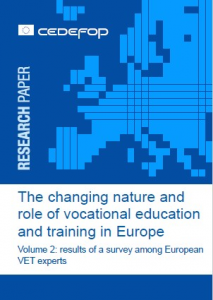5 Cedefop publications in the framework of the project ‘Changing nature and role of VET in Europe’
The first publication (volume 1) in the course of the Cedefop project ‘Changing nature and role of VET in Europe‘ discusses how VET (Vocational Education and Training) is usually conceptualised and how this can be transferred into an analytical framework valuable for the whole project.

The first publication (volume 1) in the course of the Cedefop project ‘Changing nature and role of VET in Europe‘ discusses how VET (Vocational Education and Training) is usually conceptualised and how this can be transferred into an analytical framework valuable for the whole project.
The second paper (volume 2) deals with the results of an empirical study among the EU28 (+ Iceland and Norway) on diverging national terminologies, definitions, conceptions of VET, and their implications on a common European understanding of VET.
The third paper (volume 3) provides important insights into the responsiveness of national VET systems, notably in relation to changes in demography, technology and the economy based on an analysis of developments during the past two decades (1995-2015). In addition to the paper, case studies for 10 countries (e.g. England, Estonia, Finland, France, Germany, Greece, Italy, Norway, Poland, and the Netherlands) are also available.
The fourth paper (volume 4) identifies and analyses patterns and trends in enrolment in upper secondary initial vocational education and training (IVET) in Europe over the period 1995 to 2015. The research produces findings on the comparability of the international data as well as trends in enrolment in upper secondary IVET and its share of enrolment in upper secondary education.
The fifth paper (volume 5) focuses on education and labour market outcomes for graduates from different types of VET systems in Europe. Based on comparative analysis of labour force survey data from 2014, the report analyses the vocational effect on labour market and education outcomes, asking whether any advantages conferred by vocational qualifications in early career would be offset by disadvantages later in life.
Please find Volumes 1, 2, 3, 4, and 5 in the attachment.
Link to project.

